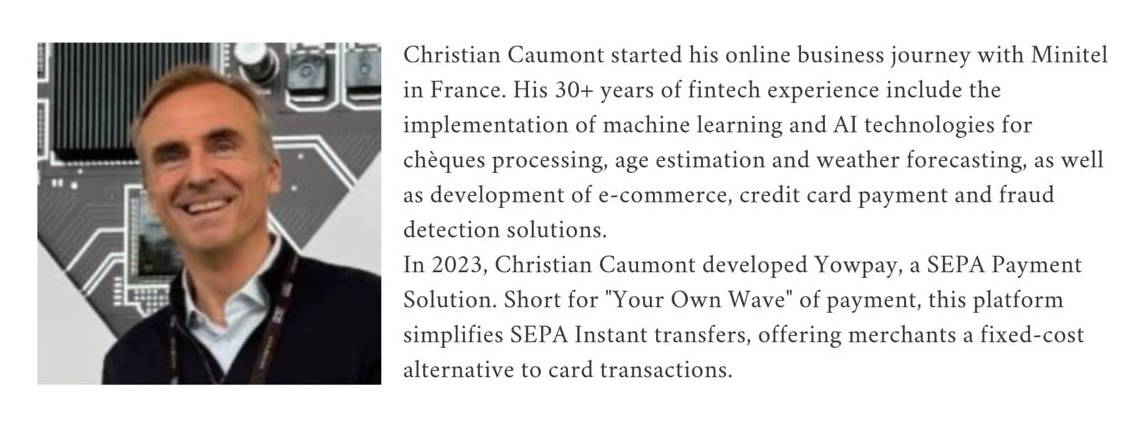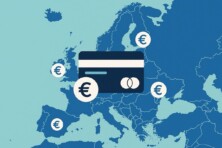While some businesses see payment landscape fragmentation in the EU as a challenge, Yowpay treats it as an opportunity to deliver real value. In this interview, Christian Caumont, CEO of Yowpay, shares his opinion on the present and future of real-time SEPA payments, the role of open banking in European e-commerce, and much more.

- With decades of experience in the online business world, you had a chance to observe how the European payment landscape evolved. How have SEPA payments changed the rules of the game for e-commerce players and payment providers?
SEPA payments have transformed European e-commerce by standardizing payments across borders. Before SEPA, cross-border transfers were slow, costly, and inconsistent, creating barriers to growth.
SEPA Credit Transfers transformed euro payments, making it simpler, faster, and cheaper, across all 36 countries. This leveled the playing field for smaller merchants and payment providers to operate internationally. It enabled one integration for multiple markets, cutting complexity and compliance costs. For payment providers like Yowpay, SEPA opened the door to building leaner, pan-European solutions. It also laid the foundation for real-time innovation, such as instant payments.
Consumers now expect fast, reliable, cross-border payments no matter where they shop.
Overall, SEPA’s evolution has driven more trust, scale, and competition in European e-commerce.
- The EU and wider SEPA region are still quite fragmented when it comes to payment acceptance. Even SEPA Instant has a fragmented infrastructure with some gaps in reachability between banks. Why do you think some countries and banks have been more reluctant to adopt SEPA instant transfers?
The EU and SEPA region remain fragmented in payment acceptance, with SEPA Instant adoption lagging due to infrastructure challenges and high upgrade costs. Limited commercial incentives, fraud and compliance concerns, and low consumer demand in some regions further slow adoption. In addition, interoperability gaps and uneven pricing, where many banks charge extra fees, discourage everyday use.
Moreover, fragmented implementation and inconsistent enforcement across countries create confusion and slow momentum. The coexistence of multiple initiatives like EPI and EPA adds further complexity and undermines the simplicity needed for widespread adoption. As less than 15% of SEPA transfers were instant in 2024, this reflects on the incomplete onboarding and inconsistent API integration. Finally, low consumer awareness and education mean many still view instant payments as niche or risky.
- Did YowPay face any challenges in providing a consistent SEPA instant experience across different jurisdictions?
Rather than seeing fragmentation as a challenge, we see it as an opportunity to deliver real value. YowPay’s core mission is to maximize success for merchants by simplifying the payment experience for their customers. That means adapting intelligently to every context, whether it’s infrastructure maturity, regulatory differences, or user preferences, while always offering the most suitable solution. Our platform is designed to abstract that complexity and ensure a seamless, optimized experience across all jurisdictions.
- Until recently, participation in SEPA Instant was voluntary. With the latest EU regulations, all SEPA banks are obliged to both send and receive instant payments. How, in your opinion, will this influence European e-commerce?
The new EU mandate for SEPA Instant participation can be a game-changer for European e-commerce.
With all banks now required to send and receive instant payments, reachability issues will disappear. This will create a truly pan-European real-time payment network, unlocking faster, more seamless transactions.
For merchants, this means regular, easy and secure instant order confirmation and cash flow, reducing reliance on slower methods, as consumers benefit from faster refunds and smoother checkout experiences. It also reduces payment fees compared to card networks, especially cross-border. Greater efficiency and lower friction will drive higher conversion rates and broader market access.
Ultimately, the new regulations mark a major step toward a more unified and competitive European digital economy.
- What is the future of SEPA payments? Can they replace cards as the preferred payment choice anytime soon? What challenges are there yet left to solve and what should be on the agenda of European payment regulators and providers today?
Instant SEPA payments have strong potential to compete with cards in everyday use. They offer lower costs, real-time settlement, and full EU coverage, which attracts both merchants and consumers.
However, for widespread adoption, the payments experience must become as seamless, secure, and widely accepted as traditional card payments. However, key challenges remain, such as a need for stronger fraud prevention tools tailored to instant account-to-account payments. Digital wallets, QR codes, and request-to-pay innovations will then be critical in making SEPA more consumer-friendly and ensure interoperability, clear rules, and competitive access for PSPs and fintechs.

- Real-time payments are surging worldwide, but Europe cannot boast the highest levels of adoption and use of instant transfers for e-commerce transactions so far. Do you currently observe any positive trends that might improve the situation?
While Europe lags behind markets like India or Brazil in instant payment adoption, positive momentum is building.
The EU mandate making SEPA Instant mandatory for all banks is a major turning point.
We’re seeing more PSPs and fintechs integrating SEPA Instant directly into checkout flows. Merchants are increasingly drawn to its benefits: lower fees, no chargebacks, and real-time settlement. Request-to-pay and open banking innovations are also making the experience more user-friendly. Cross-border instant transfers are becoming faster and more reliable, boosting confidence. The rise of API-driven platforms like Yowpay is making integration easier for businesses of all sizes. As awareness grows and infrastructure gaps close, merchant and consumer adoption will accelerate. We’re also seeing more government and B2B use cases, which drive broader acceptance.
- Where are real-time payments heading in Europe and globally?
Real-time payments are becoming the new global standard, transforming how money moves everywhere. Globally, countries like India (with UPI) and Brazil (with Pix) show what’s possible at scale. In Europe, the SEPA Instant mandate will finally unlock full reachability across all EU banks. This paves the way for real-time payments to go mainstream, especially in e-commerce and B2B. Globally, we’ll see increased interoperability between instant payment systems (e.g. EU–US–Asia corridors).
Emerging technologies like Request-to-Pay, digital wallets, and smart invoices will boost adoption. Banks and PSPs will need to rethink value-added services beyond just moving money. Regulators should focus on fraud protection, open infrastructure, and cross-border efficiency. At Yowpay, we see real-time payments driving a shift from card-based to account-based commerce.
- How is Yowpay addressing the rising challenges and opportunities in the real-time payment space? How is your solution empowering European merchants?
Yowpay is built to make real-time payments simple, secure, and accessible for European merchants. We provide seamless SEPA Instant integration with transparent pricing and fast onboarding. Our solution removes reliance on cards, helping businesses cut costs and improve cash flow. By offering real-time settlement, merchants gain instant visibility and better control over liquidity. We tackle complexity with plug-and-play APIs and user-friendly dashboards tailored to SMEs. Yowpay also supports Request-to-Pay and open banking, unlocking faster and smarter checkouts. We help merchants navigate compliance, with built-in fraud prevention and KYC tools.
Our tech ensures high uptime and reachability across the SEPA network—even across borders. We’re enabling merchants to meet rising customer expectations for speed and convenience.
- At about the same time when instant payments were introduced, the European payment industry faced a transformation fueled by open banking. How is it reshaping the merchant landscape across Europe today? What are the main open banking trends in the region?
Open banking is reshaping the European merchant landscape by unlocking direct, real-time access to consumer bank accounts.
It enables faster, cheaper, and more secure payments, cutting out card networks and intermediaries. Merchants benefit from instant settlement, lower fees, and reduced fraud risks. A key trend is the rise of account-to-account (A2A) payments at checkout, powered by open APIs. We’re also seeing growth in Request-to-Pay, improving cash flow and reducing payment friction. Open banking is fueling embedded finance, letting merchants integrate payments directly into their platforms.
Personalized financial services (e.g. credit, loyalty, or budgeting) are emerging from richer customer data access. Adoption is being driven by regulatory push (PSD2/PSD3) and improved bank API performance. Fintechs like Yowpay are bridging the gap with turnkey solutions tailored to merchant needs. Together, open banking and real-time payments are creating a faster, fairer, and more competitive payment ecosystem.
- Today, a lot of industry discussions are focused on the resilience and security of European payment systems and transaction flows. What are Yowpay and peer companies doing to boost regional payments in this area? Do you employ or plan to employ some of the latest cybersecurity technologies and innovations?
Resilience and security are foundational to trust in the European payments ecosystem.
At Yowpay, we prioritize end-to-end encryption, strong customer authentication (SCA), and real-time fraud detection. We’re investing in AI-driven anomaly detection to flag suspicious behavior before it becomes a threat. Our infrastructure is built with redundancy and high availability, ensuring consistent uptime and fast recovery. We comply with EU standards and stay ahead of evolving regulations. As SEPA Instant grows, we focus on real-time risk scoring and transaction monitoring to secure instant flows. We also advocate for shared fraud intelligence networks between PSPs and banks to act faster. Yowpay is exploring biometric and device-level authentication to further strengthen user identity checks. We believe resilience comes not just from tech, but from transparency, education, and collaboration.
Our goal is to offer merchants a solution that’s not only fast and cost-efficient—but also secure by design.
- Being an ambitious market pioneer, what are your plans for the future of Yowpay and its market impact?
Our vision is to position YowPay as an innovative alternative to solutions like Wero, by accentuating open standards to ensure interoperability, transparency, and scalability across the European payments ecosystem. By building on these foundations, we aim to foster a more inclusive, efficient, and resilient payment infrastructure that supports both businesses and consumers—while contributing to the strategic autonomy of European financial services.









